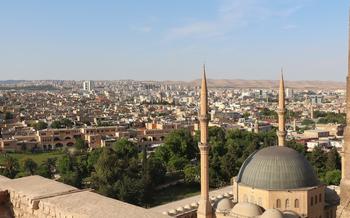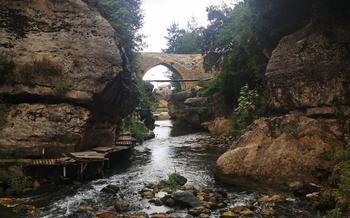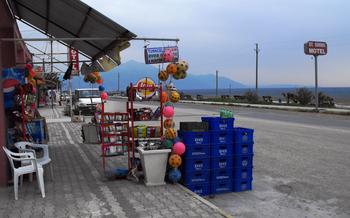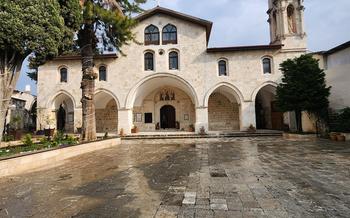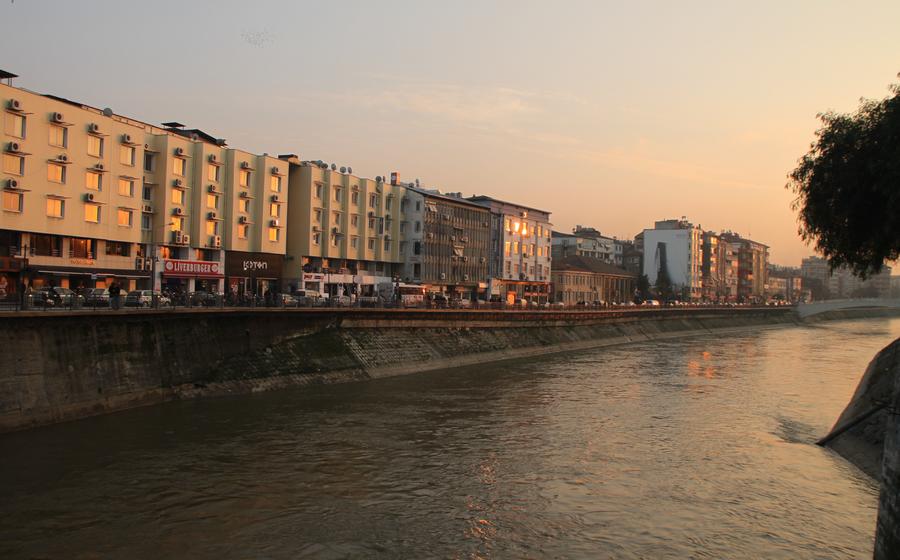
St. Pierre Church Art Gallery
- Antiquity of St. Pierre Church
- Artistic Treasures
- Mosaics and Frescoes
- St. Pierre and the Apostles
- Restoration and Preservation
- Local Artisans
- Guided Tours
- Educational Programs
- Accessibility
- Photography
- Visitor Etiquette
- Souvenirs and Gifts
- Nearby Attractions
- Local Cuisine
- Insider Tip: Unveiling the Secrets of St. Pierre Church
Antiquity of St. Pierre Church
The ancient St. Pierre Church, with its rich historical significance, stands as a prominent landmark in the vibrant city of Hatay, Turkey. Originally constructed as a pagan temple in the 4th century A.D., it underwent a transformation into a Christian basilica durante the reign of Byzantine Emperor Justinian I in the 6th century. The church derives its name from Saint Peter, who is revered as the first Pope in the Christian tradition.
The architectural style of St. Pierre Church is a captivating blend of Roman, Byzantine, and Armenian influences. Its striking features include intricate stone carvings, majestic columns, and stunning mosaics that adorn the interior walls. Situated in the heart of the old city, surrounded by bustling streets and historical sites, the church offers a glimpse into the rich cultural tapestry of Hatay.
Artistic Treasures
The St. Pierre Church Art Gallery houses a remarkable collection of artwork that spans centuries and showcases the rich artistic heritage of the region. Visitors can admire a diverse array of paintings, sculptures, mosaics, and frescoes, each piece contributing to the overall magnificence of the gallery. Among the notable works of art is a stunning mosaic depicting the Virgin Mary with the infant Jesus, a masterpiece that exemplifies the intricate craftsmanship and artistic prowess of the Byzantine era. Another highlight is a series of 16th-century frescoes portraying scenes from the life of Jesus, providing a glimpse into the biblical narratives and the religious significance of the church. The art collection at St. Pierre Church is a testament to the enduring legacy of Christianity in the region and offers visitors a unique opportunity to appreciate the artistic treasures that have been preserved within its sacred walls.
Mosaics and Frescoes
The St. Pierre Church is renowned for its exquisite mosaics and frescoes, which adorn the walls and ceilings with vibrant colors and intricate designs. These artworks date back to the early Christian era and provide a glimpse into the artistic traditions and beliefs of the time. The mosaics, crafted from small pieces of colored glass or stone, depict biblical scenes and figures, such as the life of Jesus Christ, the apostles, and various saints. The frescoes, on the other hand, are paintings executed on wet plaster, showcasing a range of subjects from religious narratives to decorative motifs. The techniques employed in creating these artworks demonstrate the skill and artistry of the craftsmen, who used a combination of pigments, binders, and glazes to achieve long-lasting and visually stunning results. The mosaics and frescoes of the St. Pierre Church not only serve as a testament to the artistic achievements of the past but also offer a profound insight into the spiritual and cultural heritage of the region.
St. Pierre and the Apostles
St. Peter, also known as Simon Peter, holds a significant position in the Christian tradition as the first among the twelve apostles chosen by Jesus Christ. In the artwork of St. Pierre Church, St. Peter is often depicted as a central figure, emphasizing his leadership and importance. He is portrayed with a dignified demeanor, often carrying a set of keys, symbolizing his role as the gatekeeper of heaven.
The apostles, as the companions and disciples of Jesus, are frequently featured in the artwork as well. They are shown in various scenes, accompanying Jesus in his teachings, miracles, and even his crucifixion and resurrection. Each apostle is represented with unique attributes and characteristics, reflecting their individual personalities and roles within the early Christian community.
The depiction of St. Peter and the apostles in the artwork not only adds to the historical and theological significance of St. Pierre Church but also provides a visual representation of the early Christian faith and the spread of Christianity throughout the region.
Restoration and Preservation
The St. Pierre Church has undergone several restoration projects to preserve its historical and artistic significance. In the early 20th century, extensive efforts were made to restore the mosaics and frescoes, which had suffered damage due to neglect and natural wear and tear. Skilled artisans painstakingly cleaned and repaired the delicate artwork, using traditional techniques and materials to ensure authenticity.
One of the challenges faced during the restoration process was the need to balance the preservation of the original artwork with the incorporation of modern conservation methods. The church authorities worked closely with experts to find innovative ways to protect the mosaics and frescoes without compromising their historical integrity.
The restoration of St. Pierre Church is an ongoing process, and continuous efforts are being made to maintain and preserve its artistic treasures for future generations. This work is crucial for safeguarding Turkey's rich cultural heritage and ensuring that the church remains a testament to the skill and devotion of its creators.
Local Artisans
The restoration of St. Pierre Church's magnificent artwork was not merely a technical endeavor; it was also a testament to the enduring skills of local artisans. These skilled craftsmen and women, deeply rooted in the traditions of their craft, played a pivotal role in preserving the church's artistic treasures.
The artisans employed time-honored techniques, passed down through generations, to meticulously restore the intricate mosaics and frescoes. Their deft hands carefully cleaned and repaired the delicate artwork, ensuring its longevity for future generations.
The artisans' deep understanding of the materials and techniques used by the original artists allowed them to seamlessly blend their restoration work with the existing artwork, creating a harmonious and cohesive whole. Their dedication and expertise ensured that the church's artistic legacy remained intact, a testament to the enduring power of traditional craftsmanship.
Guided Tours
The St. Pierre Church Art Gallery offers guided tours to enhance the visitor experience and provide a deeper understanding of the artwork and its significance. These tours are led by knowledgeable guides who are passionate about the history, art, and architecture of the church. They share fascinating stories and insights about the mosaics, frescoes, and other artworks, bringing the past to life and making the visit truly immersive.
Joining a guided tour has several benefits. It allows visitors to learn about the symbolism and biblical narratives depicted in the artwork, as well as the techniques and styles used by the artists. The guides can answer questions, provide context, and point out details that might otherwise go unnoticed. They can also share information about the history of the church, its restoration, and its importance within the Christian tradition.
Guided tours are available in various languages and can be tailored to specific interests. Visitors can choose from general tours that provide an overview of the church and its art collection to more specialized tours that focus on specific periods, artists, or themes. Advanced reservations are recommended, especially during peak tourist season, to ensure a spot on a guided tour and avoid waiting.
Educational Programs
The St. Pierre Church Art Gallery offers a range of educational programs to enhance visitors' understanding and appreciation of the artwork. These programs include workshops on art history, conservation techniques, and iconography. There are also seminars and lectures by renowned scholars and experts in the field of Byzantine art.
These educational initiatives aim to foster a deeper understanding of the historical and cultural significance of the artwork, as well as the techniques and styles used by the artists. By participating in these programs, visitors can gain valuable insights into the creative process and the symbolism behind the religious imagery.
The church also offers guided tours tailored to school groups and students of art history and religious studies. These tours provide a comprehensive overview of the artwork and its historical context, making learning about Byzantine art both engaging and interactive.
Accessibility
The St. Pierre Church Art Gallery is committed to ensuring an inclusive and welcoming environment for all visitors, regardless of their abilities or disabilities. To this end, the church has implemented several accessibility features to facilitate easy access and navigation for people with various disabilities.
Wheelchair ramps have been installed at all entrances, allowing visitors with mobility challenges to enter and exit the church without difficulty. Inside the church, wide aisles and open spaces enable wheelchair users to move around comfortably and view the artwork.
Elevators connect the different levels of the church, providing access to all exhibits and areas for visitors who may have difficulty using stairs. Braille signage and tactile displays are also available, allowing visually impaired visitors to explore the church and learn about its history and artwork through touch.
The staff at the St. Pierre Church Art Gallery is trained to assist visitors with disabilities and ensure they have a positive and fulfilling experience. They are always ready to provide assistance, directions, and any necessary accommodations to make the visit as enjoyable and accessible as possible.
Photography
The St. Pierre Church Art Gallery encourages visitors to capture the beauty of the artwork through photographs. However, it's important to adhere to specific guidelines to ensure respect for the sanctity of the religious site. Photography is permitted for personal use only, and the use of tripods or flash is not allowed to minimize distractions and preserve the artwork's integrity.
Visitors are reminded to be mindful of other visitors and maintain a respectful distance while taking photographs. While capturing the stunning mosaics and frescoes, it's essential to remember that the church is an active place of worship, and silence should be maintained to not disturb ongoing services or prayers.
By following these guidelines, visitors can document their visit and share the beauty of the St. Pierre Church Art Gallery with others while respecting the sacred nature of the space.
Visitor Etiquette
When visiting the St. Pierre Church Art Gallery, it is essential to observe proper visitor etiquette to ensure a respectful and enjoyable experience for all. Visitors are expected to maintain a respectful demeanor, appropriate to the religious significance of the site. Modest attire is recommended, covering shoulders and knees, out of consideration for the sacred nature of the church.
Silence is expected within the church to preserve the contemplative atmosphere. Conversations should be kept to a minimum, and visitors should refrain from making excessive noise or causing disruptions. Respecting the sanctity of the religious space allows everyone to fully appreciate the artwork and the spiritual ambiance of the church.
Photography is permitted within the church, but visitors should be mindful of the sacredness of their surroundings. Using flash photography is prohibited as it can damage the delicate artwork and disturb other visitors. Taking photographs should not interfere with the religious practices or the privacy of other visitors.
By following these simple guidelines, visitors can contribute to preserving the integrity of the church's artistic treasures and ensure a meaningful experience for themselves and others.
Souvenirs and Gifts
At the St. Pierre Church, visitors can delve into a treasury of souvenirs and religious items that offer a tangible connection to the site's spiritual essence. These mementos serve as cherished keepsakes, encapsulating the beauty and sanctity of the church. By purchasing these items, visitors not only support local artisans and the church's upkeep but also contribute to preserving the rich cultural heritage of the region. From intricately crafted rosaries and crosses to miniature replicas of the church's iconic mosaics, a diverse array of souvenirs awaits those seeking meaningful gifts. Whether seeking a reminder of their spiritual journey or a unique present for loved ones, visitors will find an array of treasures to cherish.
Nearby Attractions
Hatay is a treasure trove of history and culture, and there are several other fascinating attractions nearby that are worth exploring. Just a short walk from St. Pierre Church, you can visit the Hatay Archaeology Museum, which houses a vast collection of artifacts from the ancient civilizations that once flourished in the region. The Antakya Castle, with its imposing stone walls and towers, offers breathtaking views of the city and the surrounding countryside.
For those interested in religious history, the Great Mosque of Antakya, one of the oldest mosques in Turkey, is a must-visit. The Church of St. Simeon Stylites, perched atop a rocky hill, is another remarkable sight, dedicated to the legendary saint who spent decades living on a pillar.
Nature enthusiasts can explore the stunning Samandag Beach, with its crystal-clear waters and golden sands. The Daphne National Park, with its lush forests, cascading waterfalls, and ancient ruins, is another popular destination for outdoor adventures.
By planning a comprehensive itinerary, you can immerse yourself in the rich cultural tapestry of Hatay and create an unforgettable travel experience.
Local Cuisine
Hatay's culinary scene is a symphony of flavors and aromas, reflecting the rich cultural heritage and geographical diversity of the region. As you explore the city, indulge in the tantalizing array of dishes that have made Hatay famous. From the succulent kebabs grilled to perfection to the aromatic mezzes that burst with flavor, there's something to satisfy every palate.
Don't miss the chance to sample Hatay's signature dish, the künefe, a crispy pastry filled with melted cheese and topped with a sweet syrup. This culinary masterpiece is a testament to the city's culinary prowess and is a must-try for any visitor.
For a truly authentic experience, venture into the heart of the city and explore the vibrant street food stalls and local markets. Here, you'll find an array of fresh produce, traditional spices, and homemade delicacies that will tempt your taste buds.
Whether you're a seasoned foodie or simply looking to experience the local culture, Hatay's cuisine is an adventure waiting to be savored. So, come hungry, embrace the culinary delights, and let your taste buds guide you on a journey of gastronomic discovery.
Insider Tip: Unveiling the Secrets of St. Pierre Church
To fully immerse yourself in the tranquility and beauty of St. Pierre Church, plan your visit during the shoulder seasons (spring and autumn) to avoid the summer crowds. This allows you to savor the intricate details of the artwork and mosaics without distractions.
One hidden gem within the church is the small chapel dedicated to St. Peter. This intimate space features stunning frescoes depicting scenes from the saint's life, offering a glimpse into his profound influence on Christianity.
For an unforgettable experience, consider attending one of the church's special events or concerts. These events not only showcase the acoustics of the church but also provide a unique opportunity to connect with the local community and delve deeper into the cultural significance of St. Pierre.
Remember, St. Pierre Church is an active place of worship, so be mindful of ongoing services and maintain a respectful demeanor. Embrace the serenity of this sacred space, and let the beauty of the art transport you to another time and place.
